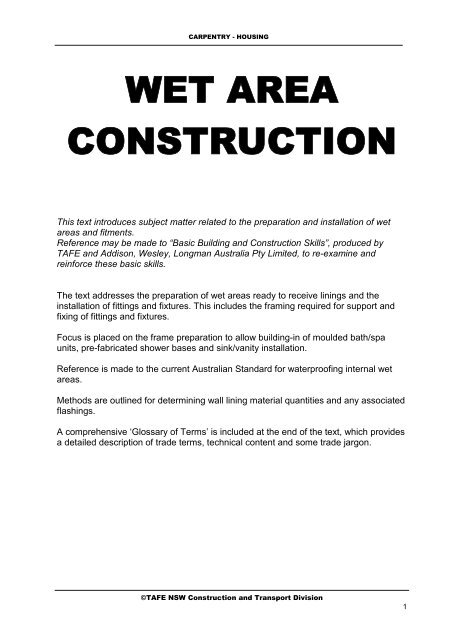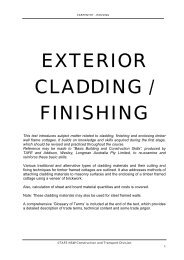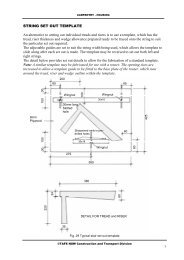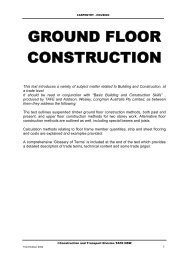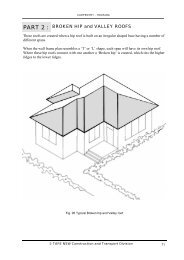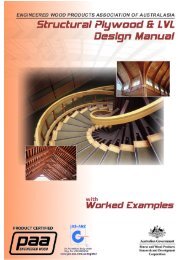TAFE wet area text.pdf - Mike's Trade Wiki
TAFE wet area text.pdf - Mike's Trade Wiki
TAFE wet area text.pdf - Mike's Trade Wiki
You also want an ePaper? Increase the reach of your titles
YUMPU automatically turns print PDFs into web optimized ePapers that Google loves.
CARPENTRY - HOUSING<br />
WET AREA<br />
CONSTRUCTION<br />
This <strong>text</strong> introduces subject matter related to the preparation and installation of <strong>wet</strong><br />
<strong>area</strong>s and fitments.<br />
Reference may be made to “Basic Building and Construction Skils”, produced by<br />
<strong>TAFE</strong> and Addison, Wesley, Longman Australia Pty Limited, to re-examine and<br />
reinforce these basic skills.<br />
The <strong>text</strong> addresses the preparation of <strong>wet</strong> <strong>area</strong>s ready to receive linings and the<br />
installation of fittings and fixtures. This includes the framing required for support and<br />
fixing of fittings and fixtures.<br />
Focus is placed on the frame preparation to allow building-in of moulded bath/spa<br />
units, pre-fabricated shower bases and sink/vanity installation.<br />
Reference is made to the current Australian Standard for waterproofing internal <strong>wet</strong><br />
<strong>area</strong>s.<br />
Methods are outlined for determining wall lining material quantities and any associated<br />
flashings.<br />
A comprehensive ‘Glossary of Terms’ is included at the end of the <strong>text</strong>, which provides<br />
a detailed description of trade terms, technical content and some trade jargon.<br />
©<strong>TAFE</strong> NSW Construction and Transport Division<br />
1
WET AREAS<br />
Definition:<br />
2<br />
WET AREA CONSTRUCTION<br />
A <strong>wet</strong> <strong>area</strong> is any <strong>area</strong> within a residential structure, which will be affected by water usage.<br />
These <strong>area</strong>s include bathrooms, ensuites, laundries, kitchens, pool <strong>area</strong>s, photographic/hobby<br />
room, partly enclosed balconies, etc.<br />
Wet <strong>area</strong>s must be designed and constructed to avoid water damage and/or penetration of the<br />
interior linings and coverings. This is achieved by following procedures contained within the<br />
Australian Standard 3740.<br />
Australian Standard<br />
The current Australian Standard applicable to <strong>wet</strong> <strong>area</strong>s is AS 3740 - 1994, which was<br />
introduced in 1989 by a standards committee for the industry to address poor waterproofing<br />
practices. This standard is currently under review with an updated version due for publication<br />
in 2002.<br />
The standard sets out requirements for waterproofing internal <strong>wet</strong> <strong>area</strong>s and the preferred<br />
construction materials and methods to be adopted. It should also be noted that all<br />
manufacturer’s requirements and recommendations be folowed to ensure ultimate performance<br />
of their products, which in turn reduces the necessity of call-backs and rectification work.<br />
Fig. 1 Typical residential <strong>wet</strong> <strong>area</strong><br />
©<strong>TAFE</strong> NSW Construction and Transport Division
Wall Frame Preparation<br />
CARPENTRY - HOUSING<br />
Wall framing to <strong>wet</strong> <strong>area</strong>s may be of a steel or timber construction. Ideally where timber<br />
framing is selected, it is preferable to use well seasoned materials with section sizes as small as<br />
possible to reduce the effects of shrinkage. One of the most common problems encountered in<br />
<strong>wet</strong> <strong>area</strong>s is as a result of material shrinkage or movement.<br />
Stud spacings should not exceed 600 mm with a row of noggings placed in-line, not staggered,<br />
behind all horizontal sheet joins for full edge support.<br />
The studs may need to be checked out to a maximum depth of 20 mm to accept and support the<br />
lip of a bath or spa. This allows for wall linings to run down over the lip to provide adequate<br />
flashing.<br />
The assembled frame should be rigid and not rely on the wall sheet lining fixing for strength.<br />
All internal and external wall stud connections should have a nest of three studs, which are well<br />
fixed and blocked at 600 mm vertical centres. Alternatively, the internal corners may be<br />
reinforced with a metal 32 x 32 mm plasterer’s angle running from botom to top plate.<br />
Additional nogging fixing should be included in the following <strong>area</strong>s:<br />
� 150 mm up from the floor around the base of a shower recess to provide sheet fixing and/<br />
or tray edge support;<br />
� Additional stud/s for shower screen fixing;<br />
� Trimmer on flat for shower head support and shower tap bridle-piece mounting;<br />
� Trimmers on flat for toilet cistern fixing and toilet control cock fixing; and<br />
� Additional trimming/noggings, as required, for other fittings and fixtures such as a vanity<br />
cabinet, towel rails, wall mounted heaters/dryers, shaving cabinets, paper holders, etc.<br />
Common studs<br />
Noggings<br />
Bottom wall plate<br />
600 c/c Max.<br />
Trimming on flat to<br />
allow for support of<br />
WC control cock,<br />
where required<br />
Trimming stud<br />
where required for<br />
shower screen<br />
fixing<br />
Trimmer on flat to<br />
allow for fixing of<br />
cistern<br />
Top wall plate<br />
Fig. 2 Preparing the wall frames<br />
©<strong>TAFE</strong> NSW Construction and Transport Division<br />
Additional trimmer<br />
to support shower<br />
head, where<br />
required<br />
Corner or end stud<br />
Additional trimmers<br />
on flat to support hot<br />
and cold water<br />
bridle piece<br />
Additional trimmers<br />
to support shower<br />
tray/flashing, as<br />
required<br />
3
Flashings and Sealants<br />
Flashings<br />
4<br />
WET AREA CONSTRUCTION<br />
Perimeter flashings must be used at the floor/wall junction in all general <strong>wet</strong> <strong>area</strong>s and must<br />
extend a minimum of 25 mm above the finished floor surface.<br />
Alternatives<br />
� A PVC flashing 75 to 100 mm x 50 mm, similar to ‘Viplas’, is adhered to the floor only<br />
with a two-part water-based resin, similar to ‘Hardies HydrEpoxy 505’, which allows the<br />
wider upturn to move independently of the wall frame and linings.<br />
These angle flashings are available in 3.0 m lengths and should be lapped at all joints<br />
around the perimeter. It is preferable to cut the narrow side only at internal and external<br />
corners, which allows the wider upturn to be folded into the corner in a continuous form.<br />
� A 130 mm wide chlorosulphonated polyethylene flashing, similar to ‘Hypalon’, may be<br />
adhesive fixed to the floor with a two-part water-based resin, similar to ‘Hardies<br />
HydrEpoxy 505’.<br />
� A 150 mm wide fibreglass mat strip may also be used around the perimeter and over floor<br />
sheet joins sealed with compatible manufacturer’s approved sealing compounds.<br />
� The vertical internal shower reces corner/s may have a 32 x 32 mm metal plasterer’s<br />
angle fixed to the studs at 600 mm centres behind the wall linings or a 50 x 50 PVC angle<br />
may be used as an alternative. In both cases the angle should extend into the shower tray<br />
or onto the pre-formed shower base and be at least 1800 mm high above the recess floor.<br />
Sealants<br />
Sealants may be used in a variety of situations for <strong>wet</strong> <strong>area</strong> applications:<br />
� Junctions between wall linings and floors;<br />
� Around baths;<br />
� Around taps if PVC aprons are not used;<br />
� Cut outs and penetrations.<br />
Suitable sealants should be<br />
flexible, similar to the silicone<br />
types, and specify their use such<br />
as brick and concrete sealant,<br />
mould resistant tile sealant or<br />
other acrylic water resistant<br />
sealant.<br />
Fig. 3 Typical tube of sealant<br />
©<strong>TAFE</strong> NSW Construction and Transport Division
Wet Area Lining Materials<br />
CARPENTRY - HOUSING<br />
Typically, <strong>wet</strong> <strong>area</strong> linings are either water-resistant plasterboard or fibre-cement sheeting.<br />
Plasterboard (Main types available)<br />
� ‘Boral Wet Area Plasterboard’ is manufactured with recessed edges for water resistant<br />
jointing in tiled <strong>area</strong>s and normal jointing beyond tiled <strong>area</strong>s. The board has face and<br />
back liners, which are resistant to moisture penetration as well as a moisture resistant<br />
gypsum core. The board is available in both 10 mm and 13 mm thicknesses. Sheet<br />
lengths range from 2400 mm to 4200 mm. The board is a distinctive green colour.<br />
�‘CSR Aquachek’ is a gypsum plasterboard with the core, face and back treated during<br />
manufacture to make it resistant to moisture and humidity. Available in both 10 mm and<br />
13 mm thickness, with 1200 mm wide sheets available in 2400 mm to 4200 mm lengths<br />
and 1350 mm wide sheets available in 3600 mm and 4800 mm. The board is a blue-grey<br />
colour.<br />
�‘Lafarge Watershield’ plasterboard. Conforms to ASTM C630. Has a water resistant<br />
gypsum core and a specially treated heavy duty linerboard. The board is a bluish<br />
colour.<br />
Fibre-cement Sheet<br />
�‘Hardies Vilaboard’ is manufactured to conform to Australian Standard AS2908.2 -<br />
1992 Cellulose - Cement Products.<br />
Mass:<br />
Villaboard is composed of Portland cement, ground sand, cellulose fibre and water and<br />
manufactured in three thicknesses, e.g. 6 mm, 9 mm and 12 mm.<br />
The 6 mm board is commonly used as a tile substrate for internal walls. The thicker<br />
sheets are recommended where there is a requirement for impact resistance. The 6 mm<br />
board is available in the following sizes:<br />
Width mm Lengths mm<br />
900 2400, 3600, 4200<br />
1200 1800, 2100, 2400, 2700, 3000, 3600, 4200<br />
1350 2400, 3000, 3600<br />
6 mm Villaboard has an approx. mass of 8.5 kg/m 2<br />
©<strong>TAFE</strong> NSW Construction and Transport Division<br />
5
6<br />
WET AREA CONSTRUCTION<br />
�‘CSR Fibre-cement Walboard’ is an autoclaved, cellulose fibre reinforced cement sheet,<br />
which is immune to water damage and will not rot. It conforms to the requirements of<br />
AS2908.2 - 1992, ‘Celulose-Cement Products Part 2: Flat Sheets’.<br />
It is manufactured in 900 mm, 1200 mm and 1350 mm widths with lengths ranging from<br />
1800 mm to 4200 mm.<br />
The sheet thickness is 6 mm and the mass is approximately 9 kg/m 2 .<br />
Fibre-cement sheeting<br />
Fibre cement sheeting is produced by two companies CSR and James Hardie.<br />
The following details provide a broad overview of cutting and installation methods.<br />
Cutting<br />
Cutting fibre-cement sheeting can be achieved in four different ways. The most traditional<br />
method is to use the Hand Guillotine, as shown below. The guillotine produces clean, straight<br />
edges, while cutting on the off-cut side of the line to allow for thickness of the blade.<br />
Hand guillotine<br />
Fig. 4 Cutting along the line with a hand guillotine (‘Fibro cuters’)<br />
©<strong>TAFE</strong> NSW Construction and Transport Division
A more popular method now used is a<br />
score and snap knife with a tungsten<br />
tipped edge.<br />
Score the face side of the sheet against<br />
a straight edge. Score 4 to 5 times to<br />
about ½ of the thickness.<br />
Support the scored edge and snap the<br />
sheet upwards for a clean break.<br />
Hardies have produced a third method<br />
for cutting using electrical powered<br />
shears for both straight and curved<br />
cuts.<br />
Hand sawing can also be used for<br />
general cutting but is best confined to<br />
small cuts as it is labour intensive and<br />
hard wearing.<br />
Small rectangular or circular holes can<br />
be achieved by drilling a series of<br />
holes around the perimeter of the hole<br />
and tapping out the waste piece from<br />
the sheet face.<br />
CARPENTRY - HOUSING<br />
Tungsten-tipped<br />
score & snap knife<br />
Fig. 5 Score, lift and snap<br />
Drill holes around<br />
circumference<br />
Support edges,<br />
then punch<br />
through with<br />
hammer<br />
Fig. 6 Methods used to create holes<br />
©<strong>TAFE</strong> NSW Construction and Transport Division<br />
Straight-edge<br />
7
Larger rectangular holes or openings<br />
are formed by scoring around the<br />
perimeter of the opening, forming a<br />
large hole in the centre as shown<br />
below.<br />
Saw cut from the centre hole to the<br />
corners of the opening, support the<br />
edges and snap away the off cuts.<br />
Installation<br />
8<br />
�Sheets should be fixed<br />
horizontally across studs.<br />
�Only a single width sheets should<br />
be placed vertically in a confined<br />
space.<br />
�Sheets should be fixed with nails<br />
or screws only in tiled <strong>area</strong>. Do<br />
not fix with adhesive when the<br />
walls are to be tiled.<br />
�Internal angles in a Villaboard<br />
system should be tied together<br />
with a continuous metal<br />
plasterer’s angle fixed at 600 mm<br />
centres.<br />
WET AREA CONSTRUCTION<br />
Straight-edge<br />
Score between<br />
cuts<br />
Fig. 7 Score, lift and snap<br />
Fig. 8 Reinforce internal corners<br />
©<strong>TAFE</strong> NSW Construction and Transport Division<br />
Lift to snap<br />
Saw cut<br />
Continuous<br />
galvanised<br />
metal angle
�In shower recesses, or other<br />
regularly <strong>wet</strong>ted <strong>area</strong>s, corners<br />
should be flashed with Hardies<br />
flash-strip.<br />
�The flashing strip must extend<br />
into the shower tray. Metal<br />
external angles or paper tape must<br />
not be used.<br />
�CSR Wallboard in a shower<br />
recess requires a 50 mm x 50 mm<br />
PVC angle in the internal corner<br />
before sheeting.<br />
�Flashing should be installed<br />
around the wall/floor junction in<br />
normal <strong>area</strong>s (when required by<br />
regulations). Flashing must be<br />
installed in shower recess<br />
systems. Flashings should be<br />
epoxy glued to the floor only.<br />
CARPENTRY - HOUSING<br />
�Sheets should be measured and cut to suit the wall sizes. Tap penetrations etc should be<br />
carefully located and cut out.<br />
�Fix sheets to framing allowing a 6 mm gap along the floor. Nail sheets at 200 mm c/c at<br />
sheet edges, ends, internals, externals and in the body of the sheet.<br />
6 mm<br />
gap<br />
Fix 50 mm min. from edge of<br />
sheet at corners<br />
200 mm<br />
max.<br />
12 mm min.<br />
Fibre-cement<br />
sheeting<br />
Bearers<br />
12 mm min.<br />
200 mm<br />
max.<br />
Fig. 10 Typical sheet fixing<br />
Fig. 9 Flash the internal corner<br />
200 mm<br />
max.<br />
600 mm max. c/c<br />
Butt joint<br />
©<strong>TAFE</strong> NSW Construction and Transport Division<br />
Metal angle<br />
Hypalon<br />
flashing<br />
Noggings must be fixed in<br />
a straight line behind<br />
horizontal sheet joints<br />
Compressed fibrecement<br />
floor<br />
sheeting<br />
9
BATH INSTALLATION<br />
Types of Baths and Spas<br />
10<br />
WET AREA CONSTRUCTION<br />
Most baths and/or spas are manufactured with a fall in the base and a moulded lip around the<br />
top to provide a finish and a flashing.<br />
The closed side/s are normally recessed into the wall frame to allow the wall lining to pass over<br />
the raised lip. This in turn provides a horizontal barrier to water and therefore prevents passage<br />
of the water into the wall cavity. As they are permanently built into the structure they are<br />
classed as ‘Fixtures’, as opposed to ‘Fitings’, which have fixings and may be easily removed.<br />
Common materials used for their construction include:<br />
� Moulded fibreglass or acrylic;<br />
� Pressed metal with a baked enamel surface;<br />
� Stainless steel; and/or<br />
� Cast iron with a baked enamel finish.<br />
Pressed metal baths and spas need to be supported around the perimeter only, whereas<br />
fibreglass/acrylic baths and spas need perimeter and base support. Most fibreglass/acrylic spas<br />
are manufactured with a steel tube cradle for permanent support under the shell. The base is<br />
usually packed with a dry sand/cement mix to provide a solid platform for load strength.<br />
Handling/Protection<br />
The surface of these fixtures is easily damaged, therefore the utmost care must be taken after<br />
installation to prevent chipping, scratching or cracking, which would lead to an expensive<br />
repair or replacement.<br />
There are some patent type repair kits available for cracked or chipped fibreglass/acrylic types,<br />
which are quite successful, however enamelled touch-ups rarely work as well. Some companies<br />
offer a complete enamel surface re-coat, in-situ.<br />
The best practice is to avoid damage<br />
in the first place by completely<br />
cover the unit with plastic,<br />
cardboard or a sheet of ply and<br />
avoid standing in the base during<br />
finishing work.<br />
Keep gritty materials, such as sand,<br />
off the surface at all costs.<br />
Fig. 11 Providing temporary protection<br />
©<strong>TAFE</strong> NSW Construction and Transport Division
Preparing the Wall Frames<br />
CARPENTRY - HOUSING<br />
The height of the bath is the most critical position in relation to the size of the tiles. Therefore,<br />
once the size of the wall tiles is determined the bath lip may be located on the side walls.<br />
Note: Most bathroom wall tiles are<br />
150 mm square and the depth of the<br />
average bath/spa is around 450 mm<br />
or approximately 3 tiles high under<br />
the perimeter lip.<br />
Set out the height of the bath lip<br />
allowing the bottom edge of the 4th<br />
course of tiles to sit over the bead<br />
onto the step in the rim.<br />
Where the tiles on the support side<br />
must align with the main wall tiles,<br />
the wall height should be determined<br />
by working down from a full tile fitted<br />
onto the flat section of the bath lip.<br />
This will ensure horizontal tile joint<br />
continuity around the bathroom and<br />
allow the cut tile edge on the support<br />
wall top course to be hidden under<br />
the rim of the bath.<br />
Top and bottom plates<br />
are out of 35 mm<br />
material<br />
Fig. 12 Setting the height of the bath<br />
©<strong>TAFE</strong> NSW Construction and Transport Division<br />
150<br />
2 2<br />
150<br />
150<br />
35<br />
491<br />
2<br />
11
WET AREA CONSTRUCTION<br />
Supporting the Rim on the Closed Side<br />
It is preferable to have continuous edge support where the bath lip is recessed into the stud<br />
wall. Also, the bottom edge of the wall lining needs continuous support between the studs.<br />
The simplest method of achieving this is to recess timber battens, one above and one below the<br />
lip, flush with the wall frame to a depth of 20 mm. This will allow the bath edge to slide into<br />
the wall and allow the wall lining to pass over the lip to provide a flashing.<br />
The batten on top provides support and fixing for the length of the sheet between studs.<br />
An alternative method is to cut and fix noggings between the studs, as shown below:<br />
12<br />
Nogging or<br />
trimmer<br />
Fig. 13 Method 1<br />
3 - 5 mm<br />
flexible<br />
sealant<br />
5 - 15 mm<br />
flexible sealant<br />
Continuous<br />
support<br />
trimmer<br />
Water resistant wall<br />
lining<br />
Wall tiles<br />
Fig. 14 Method 2<br />
©<strong>TAFE</strong> NSW Construction and Transport Division<br />
Water resistant wall<br />
lining<br />
3 - 5 mm<br />
flexible<br />
sealant<br />
Wall tiles<br />
Continuous top<br />
ribbon batten for<br />
fixing and support<br />
5 - 15 mm<br />
flexible sealant<br />
Continuous<br />
bottom ribbon<br />
batten for<br />
support
CARPENTRY - HOUSING<br />
Supporting the Rim on the Open Side<br />
Supporting frames for the open sides of the bath/spa are usually constructed from seasoned<br />
timber.<br />
Note: Treated pine is not necessary, provided the correct amount of ventilation is provided as<br />
per AS/NZS 2023 - 1995.<br />
Alternative materials may also be used such as brickwork and ‘Hebel’ block.<br />
Which ever materials are used, the structure must be rigid to prevent movement during use.<br />
Any movement may lead to bath/spa damage and tile damage to the perimeter.<br />
Common Timber Framing methods<br />
Method:<br />
STEP 1 Determine the overall size of the frames by plumbing down the outside edge of the<br />
bath lip on all open sides.<br />
STEP 2 Measure in from these marks a distance equal to the thickness of the rim, plus the<br />
thickness of the wall tiles, plus the thickness of the wall lining, e.g.<br />
3 + 10 + 6 = 19 mm<br />
Fig. 15 Supporting the open side<br />
STEP 3 Measure the overall width and length of the frames.<br />
Measure the height from the floor surface to the underside of flat support section of the<br />
bath rim.<br />
Now construct the frames with stud spacings at Max. 450 mm centres.<br />
Note: The top plate should be placed on edge to allow a clear fit under the rim.<br />
©<strong>TAFE</strong> NSW Construction and Transport Division<br />
13
WET AREA CONSTRUCTION<br />
The two methods shown below are used to support the open side of the rim when:<br />
� The rim sits onto a tiled hob section; or<br />
� The tiles fit under the rim.<br />
14<br />
Flexible bedding<br />
and sealant<br />
Support batten<br />
under bath lip<br />
70 mm support<br />
wall framing<br />
Bath lip onto<br />
tiled hob<br />
Fig. 16 Rim resting on a tiled hob<br />
Tile corner trim<br />
Waterproof<br />
wall lining<br />
Tiled support<br />
wall<br />
Floor tiles and<br />
mortar bed<br />
70 mm timber support<br />
wall framing<br />
Flexible bedding<br />
and sealant<br />
©<strong>TAFE</strong> NSW Construction and Transport Division<br />
Bath lip over<br />
face of tiled<br />
support wall<br />
Waterproof<br />
wall lining<br />
Fig. 17 Tiles finish up under the rim<br />
Tiled support<br />
wall<br />
Floor tiles and<br />
mortar bed
Providing Adequate Ventilation<br />
CARPENTRY - HOUSING<br />
Once the frames are complete and sheeted with Villaboard, prepare at least two openings to<br />
take tile bath vents to allow sufficient ventilation under the bath to dry out any trapped condensation.<br />
AS/NZS 2023 - 1995 states, “Every enclosed air space under a bath should be provided<br />
with ventilation openings having an aggregate clear <strong>area</strong> of not les than 5000 mm²”.<br />
Note: Where spas are used, access to the pump may be from outside, therefore the access panel may be<br />
a permanently vented metal plate, which will provide the necessary ventilation. This negates the need<br />
for vents internally.<br />
©<strong>TAFE</strong> NSW Construction and Transport Division<br />
150<br />
Fig. 18 Fitting vents under the bath<br />
75<br />
15
Baths and Bath Framing<br />
16<br />
WET AREA CONSTRUCTION<br />
The details below outline a typical bath profile and the completed framing required to support<br />
this type:<br />
END ELEVATION<br />
Nogging/trimmer for<br />
wall lining support<br />
and fixing<br />
PLAN<br />
ELEVATION<br />
Fig. 19 Typical bath detail<br />
Support batten<br />
under bath lip<br />
Notch for<br />
bath lip<br />
Fig. 20 Completed bath framing<br />
Open-side<br />
framing<br />
©<strong>TAFE</strong> NSW Construction and Transport Division
Hobs and Hob Walls<br />
CARPENTRY - HOUSING<br />
Hobs are generally raised or flat tiled sections at one or both ends of a bath. The main purpose<br />
of a hob is to close off the <strong>area</strong> left between the length of the bath and the walls.<br />
A raised hob is usually formed between the end of the bath and a shower to provide closure<br />
between them. It may also be used to fix the side panel of a glass shower screen and/or to<br />
mount the taps for the bath.<br />
Fig. 21 Flat hob end Fig. 22 Raised hob wall<br />
Set Out / Construction<br />
The height of a raised hob wall should be set<br />
out to suit full wall tiles. The raised section<br />
of the hob wall is usually one tile course<br />
above the bath to provide a flashing and a<br />
finish between bath and shower.<br />
A gauge rod is used to set the height of the<br />
wall to allow full tiles from finished floor to<br />
the top edge. This rod is also used to set the<br />
height of the bath, so the top of the bath will<br />
work full tiles.<br />
The hob wall may be constructed from<br />
timber framing and lined with Villaboard,<br />
similar to the support side of the bath, or it<br />
may be of masonry. Brick, concrete block<br />
and Hebel block are suitable materials.<br />
Note:<br />
� The width of the hob wall should also be set<br />
out to suit full tiles where possible, however<br />
this is usually determined by the width of the<br />
bath.<br />
� Timber must not be used for shower recess<br />
hobs.<br />
Raised hob wall<br />
Bath<br />
Finished<br />
tiled floor<br />
Fig. 23 Set height using a gauge rod<br />
©<strong>TAFE</strong> NSW Construction and Transport Division<br />
Shower screen<br />
Gauge rod set<br />
out to top of<br />
tile courses<br />
Finished shower<br />
recess floor<br />
17
WET AREA CONSTRUCTION<br />
SHOWER BASE INSTALLATION<br />
A shower base may be described as:<br />
“A pre-formed, pre-finished vessel, which is installed as the finished floor of a shower<br />
compartment and which is provided with a connection point to an approved sanitary drainage<br />
system.”(reference AS 3740)<br />
A shower base may be used as an<br />
alternative to a shower tray, or<br />
waterproof liner, which is tiled on a<br />
sand/cement bed with a fall to the<br />
waste.<br />
The pre-formed shower base may be<br />
manufactured from:<br />
� Pressed metal with a baked<br />
enamel finish;<br />
� Polymarble/Acrylic;<br />
� Concrete; or<br />
� Stainless steel.<br />
Before installation, the shower base<br />
should be checked for size to allow<br />
accurate positioning for the waste<br />
connection and check out depth for<br />
wall frames.<br />
Prepare Wall Frames<br />
The internal corner where the shower recess <strong>area</strong><br />
is to be formed must be prepared prior to the wall<br />
frames being erected. Valuable time is wasted,<br />
tools are readily damaged and the task is made<br />
more difficult if the frames are modified after<br />
erection.<br />
STEP 1 Mark the height of the base from the<br />
bottom of the wall plate, plus an<br />
additional 15 mm to allow for<br />
installation and bedding on a sand/<br />
cement ballast.<br />
STEP 2 Mark the thickness of the lip in from<br />
the face of the stud.<br />
STEP 3 Cut out the waste from the studs and rip<br />
the plates, to form the recess.<br />
STEP 4 Cut and fix noggings between studs<br />
around the top of the base to provide<br />
wall sheet fixing.<br />
18<br />
PLAN<br />
Check length<br />
(915 x 915<br />
preformed<br />
base)<br />
Fig. 24 Critical measurements<br />
©<strong>TAFE</strong> NSW Construction and Transport Division<br />
Check position of<br />
waste outlet<br />
Check width<br />
Fig. 25 Critical measurements<br />
To allow base lip to fit<br />
behind face of stud<br />
Height of base plus<br />
clearance for mortar<br />
bedding
Positioning the Base<br />
Concrete Slab<br />
CARPENTRY - HOUSING<br />
Care should be taken to accurately position the shower base in the wall frames to ensure the<br />
waste pipe will drop into the sewer pipe cast into the slab. A 100 mm diameter cap with an<br />
opening to take the shower base waste pipe is placed over the sewer pipe end and rotated to<br />
ensure alignment.<br />
Note: It is critical that the drainage is accurately placed prior to slab placement, as modifying<br />
the position with elbows and offsets later is very time consuming and costly.<br />
Timber Platform Flooring<br />
The advantage of a suspended timber floor allows the drainage to be easily fitted under the base<br />
after the base is installed, or the drainage is more easily modified if inaccurately positioned<br />
before base installation.<br />
To locate the opening in the floor for the base, before bedding the base, place the base in its<br />
final position and mark the centre of the floor waste through the hole in the base.<br />
Once the preparation is complete, the shower base may now be installed on a bed of sand/<br />
cement ballast to allow for levelling and full support for the internal <strong>area</strong> of the base.<br />
The walls are now ready for lining, as shown below: (Note: plumbing has been omitted)<br />
Fig. 26 Base bedded into position<br />
©<strong>TAFE</strong> NSW Construction and Transport Division<br />
19
WET AREA CONSTRUCTION<br />
INSTALLATION of SINK/VANITY UNITS<br />
Wet <strong>area</strong> fitments include the following:<br />
� Laundry tubs;<br />
� Bathroom/Ensuite vanity units;<br />
� Bathroom/Ensuite wall cabinets;<br />
� Laundry benches; and<br />
� Laundry cabinets.<br />
Many plans come with a bathroom or <strong>wet</strong> <strong>area</strong> layout plan for fitments. The size of the units,<br />
position within the room and the finished height of bench tops is usually noted on these details.<br />
These details are useful for the preparation of wall frames so additional studs, noggings and/or<br />
fixing blocks may be positioned for future fixing.<br />
20<br />
VIEW 1 VIEW 2 VIEW 3<br />
PLAN of Bathroom and Ensuite<br />
BATHROOM<br />
Fig. 27 Wet <strong>area</strong> fitment details<br />
ENSUITE<br />
VIEW 4<br />
©<strong>TAFE</strong> NSW Construction and Transport Division
Installing Vanities and Benches<br />
CARPENTRY - HOUSING<br />
Normally bathroom vanities and laundry benches are installed after the floors are tiled.<br />
A levelled base or plinth is fastened to the tiles to provide a sound level surface for the vanity<br />
carcass to sit on. Some vanities are constructed with the plinth as part of the cabinet.<br />
The water resistant kickboard facing lifts the carcass off the floor and away from contact with<br />
surface water. It is normally set at 75 to 150 mm high.<br />
The vertical face of the carcass is checked for plumb and the top checked for level in both<br />
directions. The back is fastened to the wall through a batten at the top and the base is fixed<br />
down to the plinth. Screws are used to hold the vanity tightly into place.<br />
Screw fixing<br />
through batten<br />
Screw fixing to plinth<br />
Unit checked for level<br />
Fig. 28 Installing the vanity and checking for position<br />
©<strong>TAFE</strong> NSW Construction and Transport Division<br />
Unit checked for plumb<br />
21
Once the carcass has been<br />
plumbed and levelled, the<br />
back rail of the cabinet is<br />
screw fixed to the stud wall.<br />
It is advisable to use at least<br />
two fixings in the length of<br />
the rail, to provide solid and<br />
stable attachment.<br />
The bottom rail, if present, is<br />
also screwed to the stud wall<br />
or the base of the cabinet<br />
may be screwed to the solid<br />
plinth underneath.<br />
If the vanity top does not have a<br />
built-in or moulded upturn at the<br />
back, to prevent water passing<br />
behind the cabinet, then a flashing<br />
should be installed.<br />
The flashing may be in the form of:<br />
� An ’L-shaped’ non-corrosive<br />
metal or plastic flashing strip<br />
fitted to the wall on top of the<br />
cabinet fixing rail, before the<br />
top is secured;<br />
� An ’L-shaped’ non-corrosive<br />
metal or plastic flashing strip<br />
cut into the back edge of the<br />
top, before the top is fitted; or<br />
� A full length bead of flexible<br />
waterproof sealant applied<br />
between the fitted top and the<br />
wall lining.<br />
22<br />
WET AREA CONSTRUCTION<br />
Fig. 29 Fixing the rail to the stud wall<br />
Fig. 30 Typical flashing methods<br />
©<strong>TAFE</strong> NSW Construction and Transport Division<br />
Sealant between wall<br />
and fixing batten<br />
‘L-shaped’ flashing let<br />
into back edge of top<br />
Sealant between wall<br />
tiles and top
CARPENTRY - HOUSING<br />
Fig. 31 Vanity with splashback - Flashed during assembly<br />
Fig. 32 Moulded top vanity with built-in upturn - no additional flashing required<br />
©<strong>TAFE</strong> NSW Construction and Transport Division<br />
23
Fasteners<br />
Fixing to Timber Frames<br />
Standard countersunk wood screws are<br />
suitable for general carcass fixing,<br />
however particleboard screws may be used<br />
for additional holding power or when<br />
attaching particleboard tops to the carcass.<br />
Round head screws and cup washers may<br />
be used where the fixings are exposed.<br />
Due to loads imposed by wall-mounted<br />
fixtures the diameter or gauge of the<br />
screws should be at least 8 to 10 gauge to<br />
prevent shear. The screws should penetrate<br />
the timber frame by at least 30 mm to<br />
resist pulling out.<br />
Note:<br />
Toggle bolts may be used for fixing<br />
through wall sheeting for light loads.<br />
Fixing to Steel Frames<br />
Steel wall frames require special fasteners,<br />
which are capable of drilling and tapping in<br />
one go.<br />
Suitable fasteners for this application would<br />
be ‘Wing-tek’ screws, commonly used for<br />
general steel frame construction and<br />
connection.<br />
24<br />
Fixing to Masonry Walls<br />
For light fixing, a plastic ‘Star plug’ and<br />
fully threaded screw would be suitable.<br />
For heavy duty fixing where loads are<br />
expected to be great, a masonry anchor<br />
would be suitable.<br />
WET AREA CONSTRUCTION<br />
Countersunk head Raised head<br />
Fig. 33 Suitable screw fixings<br />
Fig. 34 Wing-tek screw fixings<br />
Fig. 35 Star plug and screw Fig. 36 Masonry anchor<br />
©<strong>TAFE</strong> NSW Construction and Transport Division
Installing Laundry Cabinets/tubs<br />
CARPENTRY - HOUSING<br />
Most laundry cabinets, with a 45 to 60 litre top mounted stainless steel tub, are made of metal<br />
finished with a baked enamel or powder-coated surface. (plastic cabinets are also available)<br />
They have metal rails, top and bottom, at the back to allow the cabinet to be screw fixed to the<br />
wall and the tub is fitted after.<br />
The stainless steel tubs have an upturn along the back edge, approximately 15 mm high, which<br />
is also screw-fixed to the wall. The wall tile splashback is then laid over the top to form a<br />
waterproof joint, which prevents water running down the back.<br />
Note: Where tubs are fitted to an internal corner of the laundry, a flexible waterproof sealant<br />
should be run between the tub and wall before the splashback is laid.<br />
Fig. 37 Typical laundry tub installed to a corner<br />
©<strong>TAFE</strong> NSW Construction and Transport Division<br />
25
WET AREA CONSTRUCTION<br />
Water Damage, Decay and Fungal Growth<br />
Water damage may occur due to poor flashing practices, poor ventilation or using materials,<br />
which don’t provide adequate resistance to water penetration.<br />
The result of this water penetration may be:<br />
� Timber decay in wall framing;<br />
� Timber decay in floor framing;<br />
� Fungal damage to surrounding materials;<br />
� Swelling of manufactured boards such as particleboard;<br />
� Musty odours from enclosed spaces;<br />
� Damage or staining to fitments.<br />
Fungal Growth<br />
Timber decay is caused by fungal growth feeding on the lignin and cellulose, which makes up<br />
the bulk of the timber’s structure.<br />
To exist the fungi will require suitable conditions, as follows:<br />
� A food source, such as timber;<br />
� Water or a high moisture content, i.e. above 18%; and<br />
� Oxygen.<br />
The fungi, unlike plant forms, does not need light to exist therefore, dark moist places are very<br />
suitable for it’s existence.<br />
Fungi produce fruiting bodies, which develop spores. These spores are dispersed and become<br />
new fungal growths having an appearance like a surface root system, known as mycelium.<br />
Most fungi or ‘rot’ require high levels of moisture, at least 18% to start, however there is one<br />
species, Sepula lacrymans (commonly caled ‘Dry rot fungi’), which requires only humid<br />
conditions to survive.<br />
(refer to Building Materials and Hand Tools for more details relating to Fungi)<br />
26<br />
Fig. 38 Typical result of leakage from a poorly flashed fitment<br />
©<strong>TAFE</strong> NSW Construction and Transport Division
CARPENTRY - HOUSING<br />
GLOSSARY OF TERMS<br />
Carcass -The main body or frame of a cupboard or vanity. Consists of the sides,<br />
back and base.<br />
Fittings -These include any item in a <strong>wet</strong> <strong>area</strong>, which may be easily removed.<br />
They normally are fixed to the wall surface with screws.<br />
Fixtures -These include any item in a <strong>wet</strong> <strong>area</strong>, which is built-in or permanently<br />
fixed into place and not designed for easy removal.<br />
Hebel -This is a lightweight, autoclaved, aerated sand/cement product, which<br />
includes aluminium paste reacting with water to form a gas and create<br />
trapped air bubbles in the finished product. Used in <strong>wet</strong> <strong>area</strong>s in block<br />
form under baths to support sides.<br />
Hob -A raised, narrow section of wall forming a partition between fitments<br />
such as a bath and a shower recess or as a raised edge across the front of<br />
a shower recess to keep water in.<br />
Hypalon -A trade name for a chlorosulphonated polyethylene flexible angle for<br />
use up the vertical corner of a shower recess, behind the wall linings to<br />
create a waterproof seal.<br />
Patent -This is a term used to describe a product which has had its design<br />
registered with the Patents office. It is the original idea of a person or<br />
persons, which cannot be copied without consent.<br />
Polycarbonate -A plastic material, which is tough, flexible, waterproof, and resists the<br />
breakdown effects of the suns UV rays. It is used for roof sheeting<br />
material, as it is very durable and under most circumstances, hail proof.<br />
It may be formed into corrugated, ribbed or sandwich panel profiles.<br />
PVC -Polyvinyl chloride. A plastic product commonly used for sewer pipe<br />
and fitting production.<br />
Staggered -This refers to the placement of solid bridging, noggings, trimmers, etc.<br />
by offsetting every piece from the previous one, when placed in a row.<br />
Viplas -A trade name for a PVC waterproofing angle product.<br />
Wet <strong>area</strong> -Any <strong>area</strong> within a residential structure, which will be affected by water<br />
usage.<br />
©<strong>TAFE</strong> NSW Construction and Transport Division<br />
27
28<br />
WET AREA CONSTRUCTION<br />
FURTHER READING<br />
Australian Standards Committee, 1994, AS 3740 –Waterproofing of <strong>wet</strong> <strong>area</strong>s within<br />
residential buildings, Standards Association of Australia Homebush, Sydney.<br />
Note: (also refer to 2002 update to this standard)<br />
Boral and CSR manufacturer’s brochures for the instalation of wal linings to <strong>wet</strong> <strong>area</strong>s.<br />
Hadlington, P., and John Gerozisis, 1995, Urban Pest Control in Australia, NSW University<br />
Press, Kensington, NSW, Australia.<br />
Teachers of Building, 1996 Reprinted 1997, 1998, Second Edition 1999, Basic Building and<br />
Construction Skills, Addison Wesley Longman Australia Pty Ltd, South Melbourne.<br />
Ward-Harvey K., 1984, Fundamental Building Materials, Sakoga Pty Ltd, Mosman NSW.<br />
©<strong>TAFE</strong> NSW Construction and Transport Division


